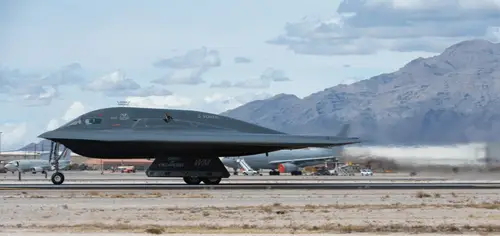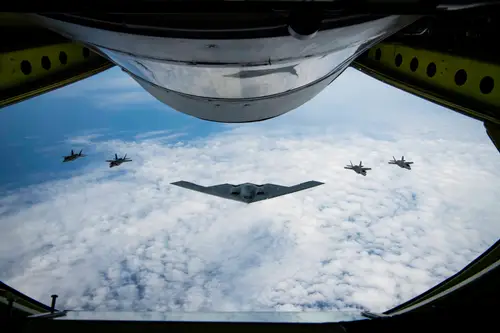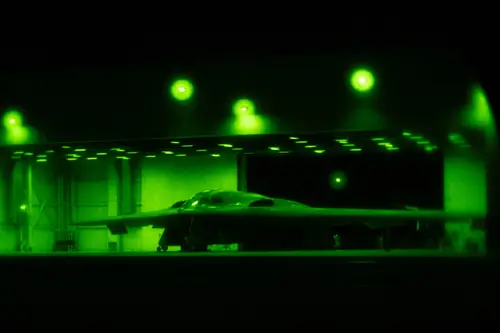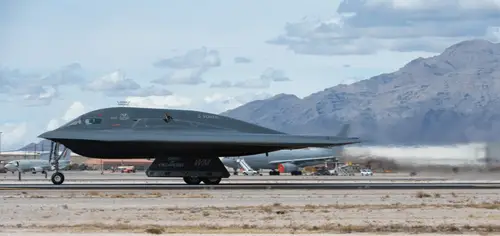Last weekend, seven U.S. stealth bombers embarked on a roughly 37-hour mission to strike Iranian nuclear facilities. The Pentagon dubbed this operation “Operation Midnight Hammer,” and it marked the longest flight undertaken by the B-2 Spirit bombers in decades.
The record for the longest B-2 flight currently belongs to Melvin Deaile and Brian “Jethro” Neal, retired U.S. Air Force pilots. In October 2001, they piloted a B-2 for 44 hours, conducting one of the first bombing missions into Afghanistan following the 9/11 terrorist attacks.
They shared their experiences of enduring these marathon bombing runs, as well as how they coped with the stressful aerial refueling of the B-2, surviving on just a few hours of sleep and beef jerky.
The Longest B-2 Flight in History
Neal told Business Insider that the 9/11 attacks happened as he and Deaile were participating in an annual nuclear capability exercise.

B-2 Spirit stealth bomber taking off during the Bamboo Eagle exercise at Nellis Air Force Base, Nevada.
Amid the chaos of reports about hijacked planes, Neal initially thought it was all part of the exercise scenario. But reality soon set in, and his unit sprang into action, preparing strike options for senior officials in the Bush administration, who were eager to respond with force.
According to Deaile, he and Neal were among the few B-2 crews dispatched to Afghanistan that very week.
Both men were already familiar with the B-2 Spirit. However, they only flew it a few times a month to preserve the expensive aircraft, which is valued at a rumored $2 billion, and to limit maintenance issues. Most of their time was spent training in the T-38, a less costly alternative to maintain sharp flying skills.
While they occasionally undertook cross-country flights in the B-2 to practice long-distance flying, they had never flown it in a real combat operation. Until one October evening, that is, when they took off in the early morning hours from Whiteman Air Force Base in Missouri—home to the entire B-2 fleet—and headed west toward Afghanistan.
Neal chuckles as he recalls the makeshift sleeping arrangements in the $2 billion stealth bomber. Before takeoff, the ground crew thoughtfully set up a foldout bed in the back of the cockpit, just long enough for one person to stretch out.
“When you pull the ladder up into the cockpit, right on the floor there’s a flat area that’s over six feet long,” Neal describes the “rest area.” “I think, in that tight space over those two days, I probably got a total of about five hours of sleep on that foldout bed.”
Five hours of sleep for a 44-hour flight is not much. According to Neal, Air Force doctors usually provide pilots with a stimulant to stay awake, colloquially known as the “go pill.” He opted not to take it, but Deaile did.
“When you’re young and doing the job you’re trained for, you get a little bit of a rush and adrenaline,” Neal recalls. Both men took turns napping, but the anxiety of the mission kept them from sleeping much. Moreover, flying west toward Afghanistan meant the sun was always shining. “It’s hard to want to sleep when the sun is shining in your eyes,” Neal says.

Piloting a B-2 Bomber
Neal explains that compared to fighter jets like the F-16 Fighting Falcon and F-22 Raptor, which he has also flown, piloting a bomber like the B-2 is akin to driving an 18-wheeler after years of driving sports cars. Deaile had experience with the strategic bomber B-52 before transitioning to the B-2 fleet, but the B-2 Spirit was an entirely different beast.
When a B-2 is cruising, only one pilot needs to be awake, while the other can rest. However, maneuvers like landing, taking off, dropping bombs, and refueling require the coordination of both crew members.
Refueling the B-2—a necessity for long-duration flights, especially when carrying heavy payloads—is no simple task.
The crew of the refueling aircraft must be specially certified to refuel each type of aircraft, including the B-2, to handle their unique characteristics. Each refueling is a 30-minute brain-taxing exercise, stressful for both the B-2 pilots and the refueling crew.
The B-2, manufactured by Northrop Grumman, is unique not only in its flying-wing design but also in its stealth capabilities, thanks to its aerodynamic shape and special coatings that help evade radar detection. The aircraft’s surface plays a crucial role in reducing observability. Deaile mentions that even minor scratches on the surface, such as those caused by contact with the refueling boom, can impact its stealth capabilities.
“It’s a very intense process,” he says of the refueling, adding that he and Neal had to refuel seven times during their two-day mission. Neal estimates they needed a total of about 750,000 pounds of JP-8 fuel. The goal was to take on as much fuel as possible, as most of the flight time would be spent over the ocean.
“It feels like you’re at a gas station that’s moving at several hundred miles an hour,” Neal quips. He describes flying the plane during refueling as a “balancing act,” especially since the B-2’s design creates lift that tends to push the refueling plane away.

A B-2 preparing to strike Iranian nuclear facilities.
Setting a Record
It was the refueling and an unexpected order from headquarters that led Neal and Deaile to set the record for the longest B-2 flight.
Deaile and Neal dropped 12 bombs over Afghanistan before exiting the country’s airspace. But just as they breathed a sigh of relief, a sudden order came down, instructing them to turn back and drop the remaining four bombs. These were the last four of their 16 Joint Direct Attack Munitions (JDAM), each weighing 2,000 pounds. JDAMs are unguided bombs retrofitted with GPS guidance kits.
However, to turn back, they needed more fuel. A refueling plane was dispatched to their B-2, named Spirit of America. Ironically, its crew had never refueled a B-2 before. They had to wait for another, certified crew nearby to be dispatched.
By this point, both pilots had barely eaten, subsisting mostly on water since they weren’t expending many calories. Neal recalls there were snacks in the cooler in the back, probably beef jerky, grapes, and sandwiches.
After dropping the last bombs, they flew south to the island of Diego Garcia, where a small U.S. Air Force base is located in the Indian Ocean. Knowing they would land there, Neal brought along a rare item on a B-2 bomber: his fishing rod.
At Diego Garcia, another crew took over the Spirit of America, and Neal and Deaile boarded a military transport plane back to Missouri.
“The ride back was much more comfortable than the ride out,” Deaile says.
Commenting on the recent B-2 mission in Iran, Deaile expresses his admiration for the maintenance and management of the fleet. With fewer than 24 B-2s in the entire fleet, the Iran mission, including decoy planes, mobilized most of America’s fleet for continuous days of flying without any breakdowns.
“In one night, the Air Force mobilized a third of its bomber fleet to execute this mission with precision,” Deaile says. “That’s unheard of.”






































